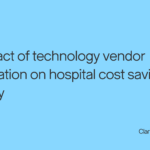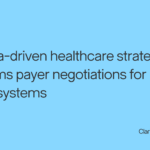More than one in every five children falls behind in recommended vaccinations before their second birthday. In support of National Immunization Awareness Month, the Clarify Health Institute explores key aspects of pediatric vaccination trends and reinforces their clinical importance by addressing common misconceptions and presenting insights from empirical analyses of vaccination rates among patients aged 0-2 years. Our analyses highlight substantial variation in vaccination rates across both patients and providers, showing gaps in adherence to recommended immunization schedules. Overall, we find adherence rates across nine separate vaccinations recommended for children before the age of two range between 69 – 86% in our national sample, consistent with prior survey evidence. National Immunization Awareness Month, observed in August, is a pivotal time to emphasize the critical role of immunizations throughout our lives. This dedicated month serves as a reminder of the importance of timely vaccination to protect children and their families from vaccine-preventable diseases and emphasizes the significance of timely vaccination. From Polio to Hepatitis A, pediatric immunizations have had a profound impact on reducing the incidence of vaccine-preventable diseases. These vaccines not only safeguard the health of individual children, but also protect vulnerable populations, including infants, older adults, and those with weakened immune systems. By ensuring timely and comprehensive immunization, we can contribute to the overall well-being of communities and create a healthier future for our children. One of the challenges to achieving high immunization rates is vaccine hesitancy and misconceptions. In the United States, vaccine hesitancy is often observed among families with lower levels of education, lower socioeconomic status, and concerns about vaccine safety and side effects Addressing concerns and providing accurate information to counter misinformation are crucial steps to overcome vaccine hesitancy. Extensive scientific research and rigorous safety measures support the safety and effectiveness of vaccines. By openly discussing concerns and providing evidence-based information, we can empower parents and caregivers to make informed decisions and prioritize their children’s immunization. In our analyses, we observe substantial variation in vaccination rates among patients aged 0-2 years, both at the patient and provider levels. Analyzing a large national sample of over 750,000 two year olds identified in commercial and Medicaid insurance claims data in 2021, we highlight significant differences in series completion rates across nine vaccinations by their second birthday in the figure below. The data reveal that approximately 56% of children had all nine vaccine series completed before turning two. We also estimate that 6.2% of children did not complete a single vaccine series by age two, with 4.4% of children having no vaccines at all by that age. Further analysis of specific vaccination rates among patients aged 0-2 years reveal important findings regarding completion of recommended series. As shown in the table below, adherence rates are observed to be lower for vaccine series with higher minimum doses, such as the Inactivated Polio Vaccine (IPV) requiring a 3-dose series, the Diphtheria, Tetanus, and Pertussis Vaccine (DTaP) requiring a 4-dose series, and the Pneumococcal Conjugate Vaccine (PCV) requiring a 3-dose series. In contrast, vaccine series with lower minimum doses, such as the Hepatitis A Vaccine (HepA), Measles, Mumps, and Rubella Vaccine (MMR), and Varicella (Chickenpox) Vaccine (VAR), demonstrate higher completion rates in the high category. These estimates highlight the significance of minimum dosing on vaccination series adherence, emphasizing the need for targeted efforts and education to improve completion rates for multi-dose pediatric vaccines and enhance overall completion rates. Considering the data further, we find that if all vaccine series that were started were effectively completed, vaccination adherence rates would increase from 10-15% across the multi-dose vaccines presented below. Aggregating results to the provider level, we also document differences in immunization practices across attributed pediatricians, with some demonstrating substantially higher rates of combined vaccination adherence than others (across each of the nine recommended series and considering vaccines from all providers). Overall, we estimate that most pediatricians promote average high vaccination rates among attributed patients; the median pediatrician maintains a timely completion rate of 78% across their young patients. However, the bottom-performing 10% of pediatricians maintain vaccination rates of only 57% or less. Identifying high-performing providers and uncovering opportunities for improvement may enable the sharing of best practices and encourage strategies to improve vaccination rates. Addressing families’ concerns, highlighting vaccine safety, and encouraging timely vaccination are vital in achieving high immunization rates. Presented analyses demonstrate substantial gaps in vaccination completion among young children throughout the US, particularly in the completion of vaccination series for multi-dose pediatric vaccines. Our work parallels other research findings showing recent declines in pediatric vaccinations due to pandemic-driven delays in primary care and increasing vaccine misinformation. National Immunization Awareness Month provides an opportunity for health systems, payers, and providers to: Vaccination is a shared responsibility that protects not only individual children but also the broader community, including seniors and immunocompromised individuals. This August, let’s use National Immunization Awareness Month as a reminder to prioritize vaccinations for children and all Americans. By promoting awareness, addressing concerns, and working together, we can create a healthier future for our children, free from vaccine-preventable diseases. Learn More: Recognizing National Immunization Awareness Month (NIAM) Key Strategies for Making Vaccine Recommendations | CDC Interventions to Increase Pediatric Vaccine Uptake: An Overview of Recent Findings Vaccination – Health, United States – CDC Childhood Immunization Status – NCQA HEDIS (Medicaid) Immunization Schedules for 18 & Younger Combined Vaccination Schedules for Children 0-18 Protecting Children and their Families from Vaccine-Preventable Diseases
Promoting Vaccinations and Ensuring Community Health
- Author Details





